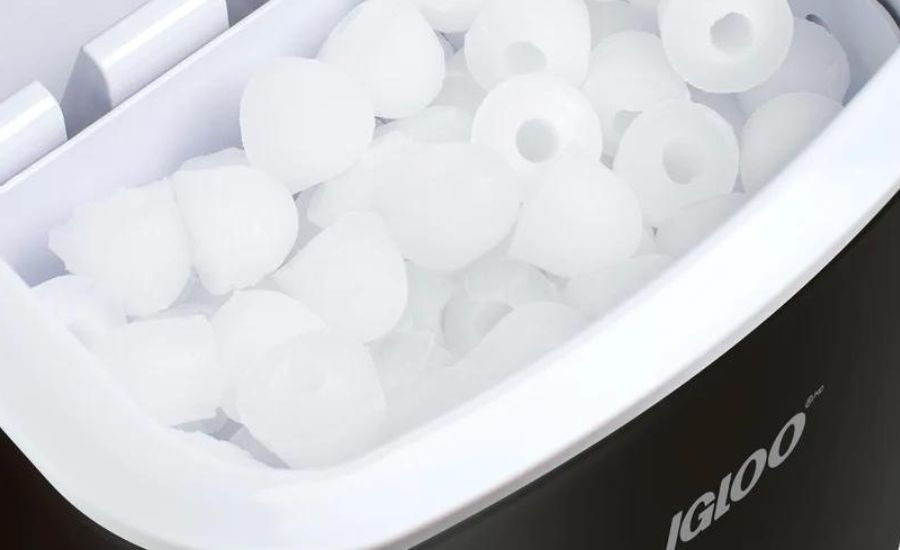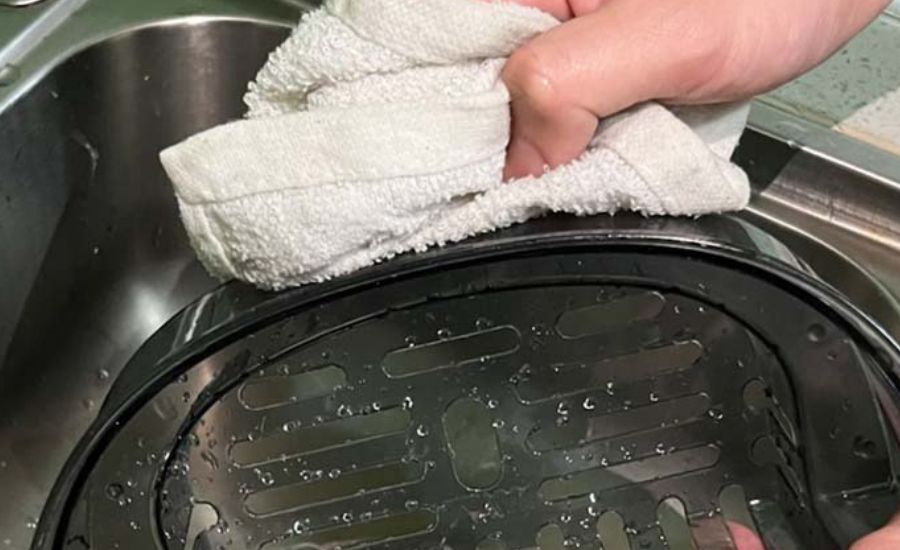
How to Igloo Ice Maker cleaning? It’s crucial to clean Igloo ice maker to create better-tasting ice cubes.

Preparation
It is vital to follow these instructions first before you clean Igloo ice maker.
Unplug the ice maker and turn off the water supply
Before beginning with any procedures take the following actions:
- Unplug the ice maker from electricity.
- Make certain the water supply is switched off.
Assemble the supplies you’ll need
You may need:
- A soft cloth
- A spray bottle
- A towel for drying
- Lemon juice
- Vinegar
- Warm water

Washing the exterior of an Igloo ice maker
Apply a damp cloth to clean the external surfaces. Lightly wipe clean the external surfaces with a soft, wet towel and a spray bottle. This will assist in getting rid of any spills, smudges, or dirt buildup on the surface.
Cleaning vents and other openings. Examine and clean the Igloo ice maker’s vents and openings.

Cleaning the ice bucket and scoop
Using warm water and a mild detergent, clean the ice bucket. To properly clean the ice bucket, use a warm water solution diluted with a little detergent or dish soap.
Using a sponge or soft brush, carefully scrub the bucket to get rid of any build-up or residue.
Make certain the drip tray and ice scoop are spotless. Likewise, use the same mix of warm water and mild detergent to clean the ice scoop and drip tray. To get rid of any residue or stuck-on particles, give the scoop a good scrub.

Sanitizing the inside of the ice maker
- In a container, combine equal parts white vinegar and fresh water to create a cleaning solution.
- Using a soft cloth or sponge, apply the vinegar and water solution. Vinegar’s mild acidity aids with the dissolution of scale and minerals.
Rinsing with cold water. After cleaning, use a separate damp cloth or sponge with clean cold water to wipe down the interior surfaces of the ice maker again, removing any residual solution.

What to do after cleaning if the ice tastes strange?
Install a filter: by including a water filter in the supply line, the quality of the water used to make high-quality ice can be greatly improved.
Thoroughly disinfect: regular cleaning of the Igloo ice maker is essential since pollutants or mold may affect the flavor and quality of the ice cubes. Use the proper sanitizer to disinfect the ice maker. Rinse well with fresh water to remove any possible residue. Consider using only high-quality specialized sanitizers.
Monitor clump formation: when cubes melt and refreeze or fuse as a result of temperature changes, the result is clumped ice. clumps can distort the ice’s shape or flavor by absorbing impurities or smells, respectively.
By breaking them up, you can make sure the ice doesn’t go bad.
Do this frequently, particularly if you see larger clumps starting to form, to keep them from growing into a bigger problem.
By using these strategies you:
- Enhance water quality: the Igloo ice maker produces clearer, fresher-tasting ice cubes when the water it uses is of higher quality, which is ensured by using a water filter.
- Prevent of impurities: routine maintenance helps keep the Igloo countertop ice maker free of contaminants or mold growth, guaranteeing that the ice it produces is flavorful and odorless.
- Get an effective sanitization: specialized cleaners offer a more thorough sanitization process, eliminating bacteria or residues that might affect the ice’s quality.

Final actions
Reassembling the parts of the ice maker:
- Make sure that every part — including the scoop, bucket, and any detachable sections — is completely dry.
- Reposition the parts within the Igloo countertop ice maker, taking care to make sure they are in the correct places.
Advice to keep the Igloo ice maker clean
These practices can help with the proper cleaning process and maintain and efficiency of your Igloo ice maker, ensuring the production of clean ice cubes.
General instructions
Below are some common practices to integrate in the upkeep.
| Practice | Description |
| Use filtered water | Filtered water: Has fewer pollutants and mineral deposits. Is ideal for cleaner ice manufacturing and less regular cleaning. |
| Empty regularly | To avoid the growth of bacteria, mold, or scale: 1. Empty the ice bin. 2. Clean the internal parts of the ice maker. 3. Wipe down the interior regularly. |
| Examine seals and gaskets | Examine gaskets and seals regularly: • Make sure they are undamaged and in good condition. • Cracked seals may cause moisture to build up and possibly even mold. |
| Maintain appropriate ventilation | Make certain there is enough airflow surrounding the countertop ice maker. Proper ventilation has two benefits: • Maintains optimal performance. • Prevents overheating. |
| Sanitizing | To get rid of germs and smells: 1. Try sanitizing the ice maker using a commercial ice maker cleaner or a solution of water and a small quantity of bleach. 2. To ensure safe sanitization, adhere to the manufacturer’s instructions in the user manual. |
Suggestions for a routine cleaning
| Frequency | Suggestions |
| Once a week | To get rid of spills and dust: 1. Use a damp cloth to clean Igloo ice maker. 2. To ensure hygienic conditions, empty and clean the ice bin. |
| Once a month | Every month, give the Igloo countertop ice maker a more thorough cleaning: 1. Make sure to use water and mild soap to wash the ice basket and scoop. 2. Scale and mineral deposits can be removed from the inside components by using a damp cloth. |
| Once a quarter | Periodically, or as directed by the manufacturer, perform a cleaning cycle on the entire machine: • It will thoroughly clean and sanitize it if you use a good cleaner or descaling solution. • This guarantees peak performance and aids in the prevention of mold and scale accumulation. |
Note: for your particular Igloo countertop ice maker model, modify the cleaning plan according to usage frequency, water quality, and manufacturer recommendations. Maintenance procedures greatly extend the lifespan of the ice maker.

Resolving further problems to maintain optimal performance
Efficiency: by following a systematic method, individuals can efficiently identify the root cause of the ice maker problem. This structured approach allows them to methodically go through potential ice maker issues step by step, eliminating possibilities and honing in on the actual problem.

Accuracy: it ensures a more accurate diagnosis. Instead of randomly checking different ice maker components or making assumptions about the problem, a systematic approach helps in logically analyzing each potential cause before moving on to the next.
Prevents overlooking issues: sometimes, an apparent ice maker problem might have an underlying cause that is not immediately obvious.
A systematic approach ensures all potential areas of concern are thoroughly inspected, reducing the chances of overlooking critical ice maker issues.
Saves time and resources: rather than randomly trying different solutions or attempting ice maker fixes that might not address the actual problem, a structured approach saves time and resources. It helps in pinpointing the exact issue, allowing for targeted solutions without unnecessary trial and error.
Safety: especially when dealing with electrical appliances like ice makers, a systematic approach helps ensure safety. It reduces the risk of ice maker accidents that might occur due to haphazard troubleshooting or handling of electrical components.
Facilitates effective communication: when seeking professional assistance or contacting customer support, having a systematic account of the Igloo countertop ice maker troubleshooting steps followed can facilitate effective communication. Clear documentation of the steps taken makes it easier to explain the problem to experts.
In essence, using a systematic approach to diagnose Igloo countertop ice maker issues is about ensuring safety, accuracy, efficiency, and optimal use of resources.

Conclusion
Keeping your Igloo ice maker clean is an essential practice for ensuring the creation of clean, better-tasting ice.
FAQ
How do you run a clean cycle on an ice machine?
If you have an Igloo countertop ice maker, you may usually perform a clean cycle:
1. Follow the manufacturer’s instructions found in the user manual.
2. Usually, it entails using a particular cleaning solution or mixture that the manufacturer suggests.
3. Add it to the reservoir of the device, doing a cleaning or ice-making cycle.
4. Give the unit a thorough rinse with clean water.
How do I get mold out of my ice maker dispenser?
1. Use a soft cloth for the dispenser of the Igloo countertop ice maker.
2. Use a specialized cleaner or vinegar.
3. After giving it a thorough rinse, scrub away any remaining mold.
4. Before using the dispenser to make fresh ice, make sure it is totally dry.
How do you keep mold out of a portable ice maker?
To avoid mold growth:
1. A portable Igloo countertop ice maker should be routinely cleaned and sanitized following the manufacturer’s guidelines.
2. To clean the internal parts, use a specific commercial cleaning or a vinegar-and-water solution.1.
3. After every use, make sure the machine is empty.
4. Keep it somewhere with good ventilation to avoid any moisture buildup that can encourage the formation of mold.
How to break up clumped ice?
Breaking up clumped ice in your ice maker is an essential maintenance task. When they stick together, it’s often due to fluctuations in temperature or extended periods of storage.
To break it up:
1. Gently tap the ice bin to break apart the larger pieces.
2. Additionally, periodically emptying the ice bin and breaking up clumps helps prevent the formation of large, solid masses that can impede functionality.

